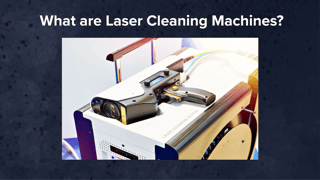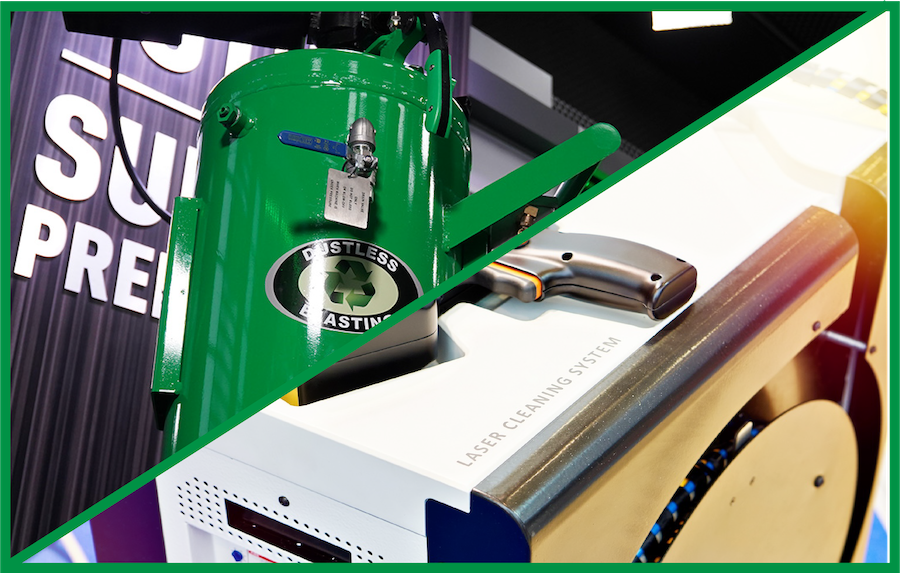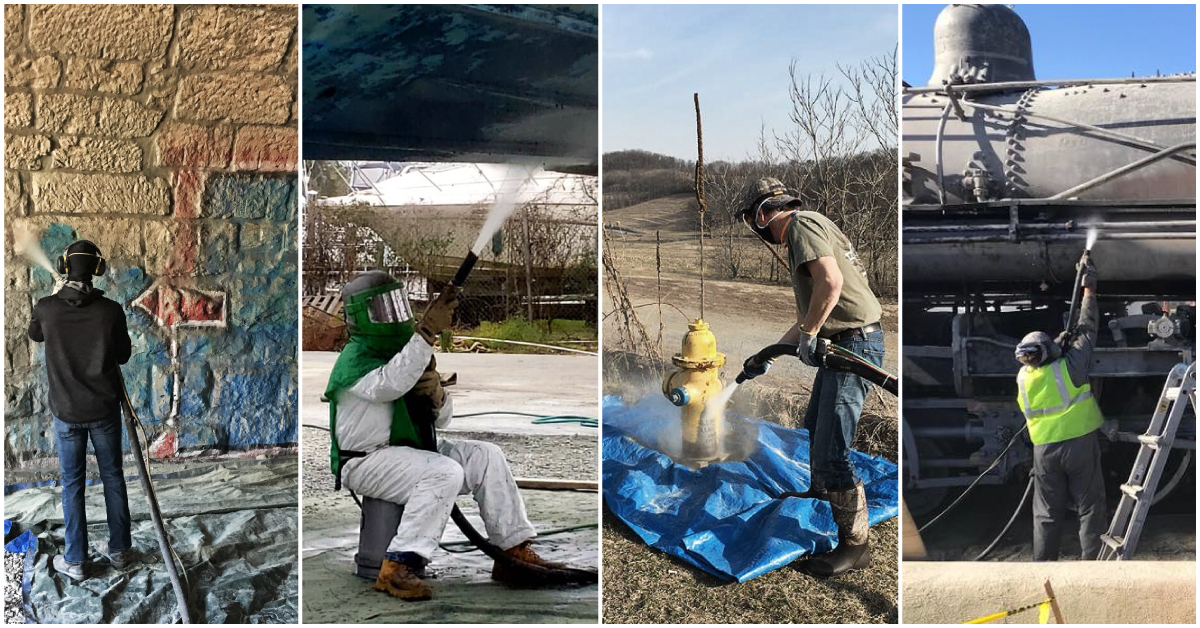
In the surface cleaning industry, technological advancements have introduced innovative solutions like laser cleaning equipment and dustless blasting to replace traditional cleaning methods. Both methods offer distinct advantages and are suitable for various applications, making it essential to understand their specific benefits to select the appropriate method for your industry or business need.
What is Laser Cleaning?
Laser cleaning is a non-contact cleaning technology that uses laser beams to remove contaminants, rust, paint, and other surface coatings. A laser cleaning machine ablates the unwanted material, turning it into gas or particulate that can be vacuumed away. This method is precise and the laser beam can be finely tuned for various substrates, making this surface treatment ideal for delicate or complex surfaces.

What is Dustless Blasting?
A dustless blaster is a pressurized machine capable of wet and dry sandblasting which makes it a versatile solution for heavy-duty cleaning, surface preparation, and coating removal. When wet blasting, water is combined with abrasive media to remove surface contaminants. This method prevents the typical dust plume associated with dry blasting, making the wet blasting method a safer and more environmentally friendly option than traditional cleaning methods or chemical cleaning. Because of the system's versatility to blast both wet and dry, Dustless Blasting is effective for a wide range of applications, from metal surfaces and concrete to wood and fiberglass.

How a Laser Cleaning Machine Works
So how does a laser cleaning machine operate? A laser cleaning system uses a high-powered laser as the cleaning tool. The laser beam is focused and directed through specialized optics and a nozzle, designed to optimize the precision and effectiveness of the laser. When the laser beam is aimed at the target surface, it rapidly heats the contaminants, causing them to vaporize or detach from the substrate without damaging the underlying material.
Most laser cleaning systems on the market include a laser source, a cooling system to prevent overheating, a delivery system consisting of optics and a nozzle, and controls that allow regulation of laser parameters such as power, frequency, and focus. Laser cleaning machines come in different sizes and capacities, depending on the scope of the job and the user's requirements.
Maintaining a Laser Cleaning System Machine

Manufacturers of laser cleaners use high-quality materials such as aluminum and stainless steel, along with advanced precision engineering, to ensure durability and optimize performance. Modern machines often include features like variable power settings, adjustable focus, and ergonomic designs for user comfort. Regular maintenance of precision parts is crucial for laser cleaners to function effectively and safely. Key tasks include:
CLEANING AND INSPECTION
Regularly inspect the laser machine for any signs of wear and tear, and clean it thoroughly after each use. Pay special attention to the optics to ensure they are free of dust and debris, which could affect the laser's performance.
COOLING SYSTEM MAINTENANCE
Ensure the cooling system is functioning properly to prevent the laser from overheating. Check coolant levels and inspect the system for any leaks or blockages.
OPTICS CARE
Keep the optics clean and properly aligned. Misalignment or contamination can significantly impact the quality and precision of the laser beam. Use appropriate cleaning tools and solutions as recommended by the manufacturer.
REPLACE WORN PARTS
Replace any worn or damaged parts of the laser machine promptly to prevent breakdowns during use. Following the manufacturer's maintenance schedule is crucial to keep the equipment in optimal working condition and prolong its lifespan. Many laser cleaning machine parts are proprietary, unlike a dustless blaster, so consider this when budgeting for maintenance.
Comparing Laser Cleaning Machines and Dustless Blasting

Precision and Control
Laser Cleaning Machines: Laser cleaning machines are known for their extremely precise cleaning. The ability to control the laser's intensity and focus allows for meticulous cleaning without damaging the underlying surface. This makes it particularly useful for delicate tasks, such as cleaning precise metal parts or utilizing laser rust removal to clean rust and other contaminants off intricate machinery parts.
Dustless Blasting: While dustless blasting is less precise than laser cleaning machines, it offers a broader approach suitable for larger surfaces and heavier coating or rust removal. The wider blast pattern and tailored blast pressure and method ensures efficient coating removal of rust, paint, grime, and other contaminants, making it ideal for preparing surfaces in the industrial and commercial sectors.
Versatility
Laser Cleaning Machines: The versatility of laser cleaning machines is evident in their application across various industries, from automotive parts preservation to medical equipment cleaning. The non-abrasive nature and precision control of laser technology makes this method suitable for sensitive surfaces that require a gentle touch or sufficient cleaning prior to laser welding.
Dustless Blasting: Dustless blasting excels in versatility, capable of handling multiple substrates and applications. Whether removing graffiti from walls, prepping vehicles for repainting, cleaning marine vessels, or other coating removal projects, dustless blasting offers a robust solution that can adapt to different materials and job requirements.

Environmental Impact
Laser Cleaning Machines: As an eco-friendly alternative, laser cleaning machines produce minimal waste and require no chemicals or abrasive media. The primary byproduct is the material removed, which is often captured and contained, reducing environmental contamination.
Dustless Blasting: Dustless blasting significantly reduces dust pollution when wet blasting, making this method a safer option for operators and the environment. However, it requires the use of abrasive media, which needs proper disposal to prevent environmental harm.
Cost and Accessibility
Laser Cleaning Machines: The initial laser cleaning machine cost can be high, and the technology's proprietary parts may require higher maintenance costs and could be hard to source when needed. However, the precision and efficiency can lead to cost savings in specific applications over time.
Dustless Blasting: Dustless blasting systems are generally more affordable and accessible. The lower upfront cost and versatility make it a practical choice for many businesses, providing a balance between effectiveness and budget considerations.
Why a Dustless Blasting Machine Might Be the Better Choice for Certain Applications
While both laser cleaning machines and dustless blasting offer unique benefits, dustless blasting stands out in several key areas:
-
Cost-Effective: For businesses looking to maximize their budget and project scope, dustless blasting offers a more affordable initial investment and operational costs.
-
Versatility: Dustless blasting can handle a wide range of materials and applications, making it a flexible choice for various industries. With the ability to wet and dry blast, the operator isn't confined to just one blast method, opening the doors to almost any surface restoration job.
-
Efficiency: The combination of versatile media choices, tailored blast method, and adjustable blast pressure in dustless blasting ensures fast and thorough cleaning, ideal for large-scale applications. With the efficiency of a dustless blaster, the operator has the opportunity churn out a production line of projects.
-
Environmental Safety: If the operator needs to work indoors or is blasting in dust-sensitive areas, wet blasting is a great option. By reducing dust and incorporating eco-friendly practices, dustless blasting presents a safer alternative for both operators and the environment.
In conclusion, while laser cleaning machines provide precision and eco-friendliness for specific applications such as metal cleaning or laser rust removal, dustless blasting offers a versatile, cost-effective, and efficient solution for broader surface cleaning and preparation needs. Understanding the strengths and limitations of each method vs. traditional methods will help make an informed decision for the particular project requirements.
